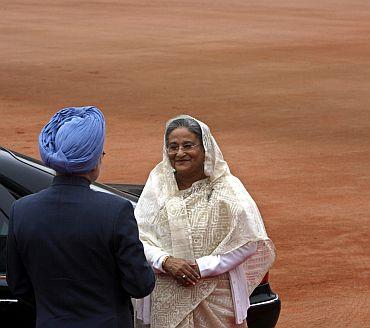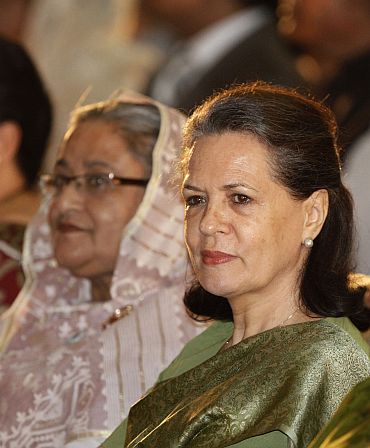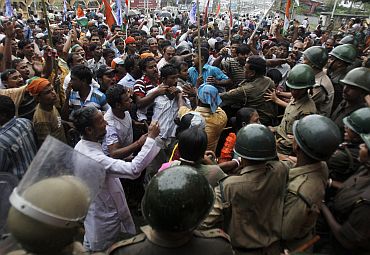 | « Back to article | Print this article |
Why PM's visit to Bangladesh promises to be groundbreaking
Prime Minister Manmohan Singh's visit to Bangladesh on September 6 and 7, his first to the eastern neighbour and the first by an Indian prime minister in 12 years, promises to take bilateral ties to the next level, reports Sheela Bhatt.
It will be massive! Historic! I think Prime Minister Manmohan Singh's visit to Dhaka is going to be on a massive scale and substantial," says Veena Sikri, former high commissioner to Bangladesh, while speaking to rediff.com.
Dr Singh's visit to Dhaka on September 6 and 7 is touted as ambitious and historic, and aimed solving bilateral issues pending since 1974. Some issues are the leftovers of history that were not settled even in 1947, when the territory was known as East Pakistan. The PM's visit will be a part of India's diplomatic endeavour to create a 'peaceful periphery'.
After Bangladeshi Prime Minister Sheikh Hasina came to power in 2008, she has taken several steps to rein in Indian insurgents and operatives of Pakistani intelligence agency the Inter Services Intelligence working out of Bangladeshi territory.
The Indian assessment is that "the presence of ISI is less today in Bangladesh than before." In dealing with the insurgent groups of the northeastern states, Hasina's government has certainly delivered.
Please click NEXT to read further...
Both countries determined to end issues blocking economic potential
This 'incredible' change in ground realities, after taking action against anti-India forces, gave India the space to work on other issues and grant an important neighbour some concessions in trade and water that it had been looking forward to since 1973.
Currently, Bangladesh has a valid reason to complain as well, because the trade balance is still in India's favour.
The flurry of activities between the two countries suggests that both are determined to put an end to issues that are blocking economic potential. When the global economy is not showing much hope, the Asian countries are expected to fix it.
Plenty of credit goes to Prime Minister Hasina's far-sighted and bold leadership in picking up the offer from Dr Singh to arrive at a series of agreements that would boost the region's economy, help stabilise bilateral security concerns, and take India, Bangladesh, Bhutan and Nepal to a 'win-win situation' by broadening their trade basket.
After both countries did joint surveys of their borders and territorial enclaves, bilateral interactions have moved fast.
Since many decades there have been Bangladeshi enclaves surrounded by Indian villages, as well as some Indian enclaves surrounded by Bangladeshi ones.
The issue over enclaves is set to be solved
And, then, there was the issue of giving transit route to the northeastern states through Bangladesh. This issue is likely to be settled, giving a huge advantage to India to develop its northeast. The user's rate for it will be decided by market forces.
India and Bangladesh share 4,096 kilometres of borders but the un-demarcated 6.5 km border issue was never settled. It is also likely to be settled now.
It's not a small event, that for the first time since 1947 both the countries will settle their disputes over 162 territorial enclaves that were stumbling blocks in the final settlement of the border.
Now these enclaves will be swapped and absorbed in the respective countries, and in effect will be wiped off the map. These 'enclaves' are called 'chit mahals' in local parlance.
Bangladesh has some 3,000 acres of land inside India while India has around 3,500 acres of land in that country. India will probably have to give up a little more land in the final settlement, that will require approval from Parliament.
Sikri says, "Much before independence the local kings used to gamble. Whoever lost sent the chit to the winner in which villages were given away. These exchanges of chits while gambling created estates on both sides. They became exclusive islands even after partition."
Two rulers of minor kingdoms, namely the raja of Cooch Behar and the nawab of Rangpur, had their kingdoms on the Teesta river. Cooch Behar remained in India while Rangpur went to Bangladesh, but their stakes in gambling created these islands.
The Union home ministry said that during surveys it was found that some 162 enclaves are inhabited by almost 51,000 people who have been a part of the continuous and sometimes tragic border tensions. These people, it is reported, don't much care for their citizenship as much as for their land and culture.
India hopes it doesn't become an issue in Dhaka politics
National Security Advisor Shivshankar Menon, who went to Dhaka to finalise arrangements for the PM's visit, has held talks with Hasina and other officials. India and Bangladesh will ink security, trade, border, water, culture and power-related agreements during the visit at the highest level.
Sikri further says, "We have seen a difficult relationship after the assassination of Sheikh Mujibur Rehman in 1974, but times have changed. To remain globally competitive, you have to first be regionally competitive. When globalisation started, oil was cheaper than it is now. Then one could ignore the next door neighbour and get cotton from Egypt or sugar from Brazil, but that's difficult now due to the prohibitive cost of transport. The settlement of border and water issues makes sense for both the countries."
India-Bangladesh relations have seen many ups and downs due to the intense competitive domestic politics on both sides, more so in Bangladesh where the two major political parties have been taking a tough stand against India when out of power.
If Hasina manages to explain her moves with Dr Singh to her domestic political constituency, only then will India-Bangladesh relations achieve a breakthrough.
Surely, India has ensured that it remained engaged with all the political parties, including main opposition Bangladesh Nationalist Party of Begum Khaleda Zia. In this round, Indian diplomats have taken care to see that 'India' doesn't become an issue in domestic politics.
The buzz over the trip is on
Mani Tripathi, former high commissioner to Dhaka, says, "We must leave domestic politics to be tackled by the respective countries. We should deal with the government of the day. I don't see any reason why the agreement to be reached by both countries during the PM's forthcoming visit won't be sustainable."
Hasina's foreign affairs advisor Gawher Rizvi has already said, "We have sorted out everything related to the visit."
West Bengal Chief Minister Mamata Banerjee, and the chief ministers of Assam, Tripura, Mizoram, and Meghalaya, states that share a border with Bangladesh, will also join Dr Singh's visit, making it truly historic.
According to a report in the Anand Bazar Patrika, Banerjee had some reservations about the agreement over sharing of the Teesta river waters. Both the countries currently share 54 rivers and have many unresolved issues over it.
The draft of the new understanding over sharing of the Teesta waters has been shown to Banerjee by NSA Menon during a special visit to Kolkata, says the report.
ABP's report claims that India will take 52 percent and Bangladesh 48 percent of Teesta water after preserving 460 cusecs (cubic feet per second). Teesta originates from Sikkim and flows into Bangladesh through Jalpaiguri (in West Bengal) and meets Brahmaputra eventually.
During his visit to Dhaka, Menon met a few editors also. Since the last few years, India has seen that civil society in Bangladesh has been very keen to take the bilateral relationship to the next level. More and more young Bangladeshis are seeking Indian visas and there is a new-found support in society for better ties with India.
Even the world is watching the positive moves between India and Bangladesh.
The Economist has published a controversial piece regarding Sheikh Hasina's increasing ties with India.
While talking about the transit point that would give India faster access to northeastern states, it says, 'Yet the new transit project may be about more than just development. Some in Dhaka, including military types, suspect it is intended to create an Indian security corridor. It could open a way for army supplies to cross low-lying Bangladesh rather than going via dreadful mountain roads vulnerable to guerrilla attack. As a result, India could more easily put down insurgents in Nagaland and Manipur. The military types fear it might provoke reprisals by such groups in Bangladesh.'
The Western publication then drags China into it.
It comments, 'More striking, India's army might try supplying its expanding divisions parked high on the border with China, in Arunachal Pradesh. China disputes India's right to Arunachal territory, calling it South Tibet. Some Bangladeshis fret that if India tries to overcome its own logistical problems by, in effect, using Bangladesh as a huge military marshalling yard, reprisals from China would follow.'
As such, the buzz over the PM's forthcoming visit to Dhaka is already on.




